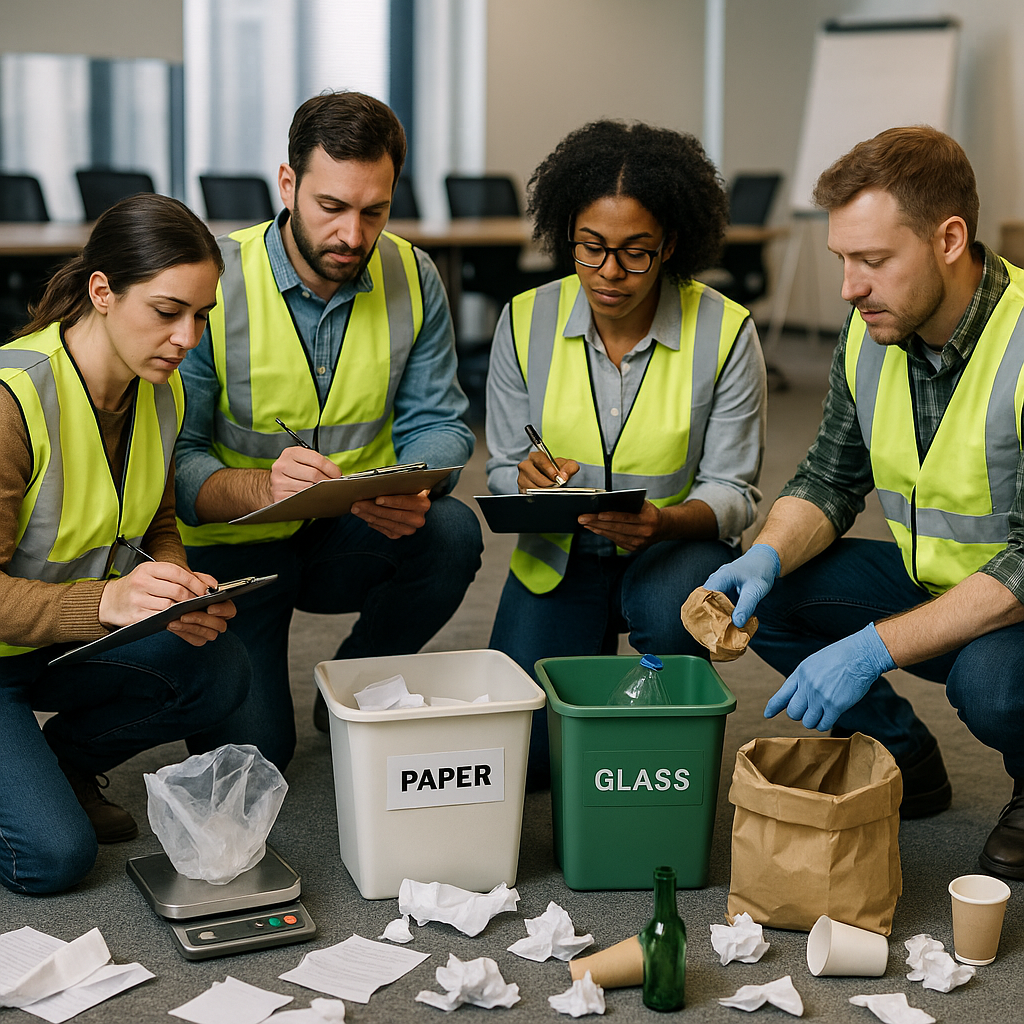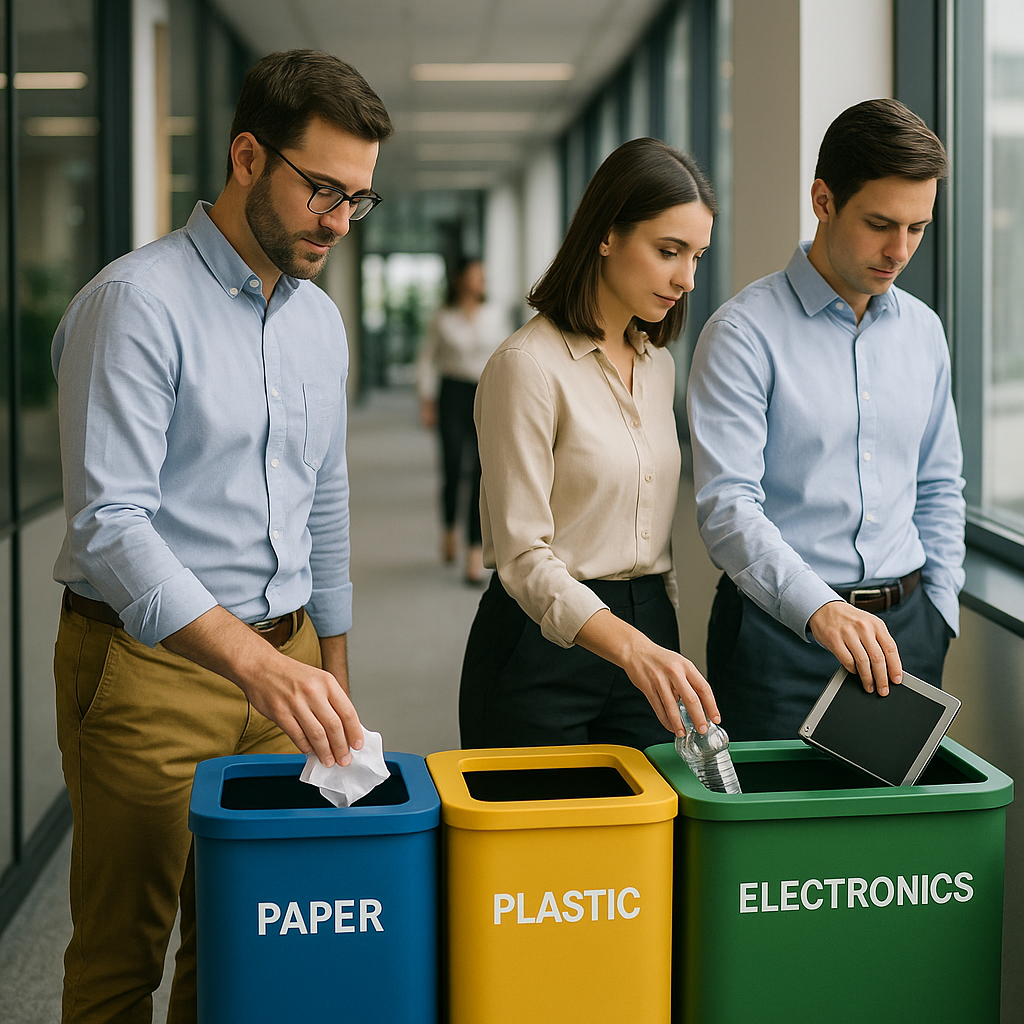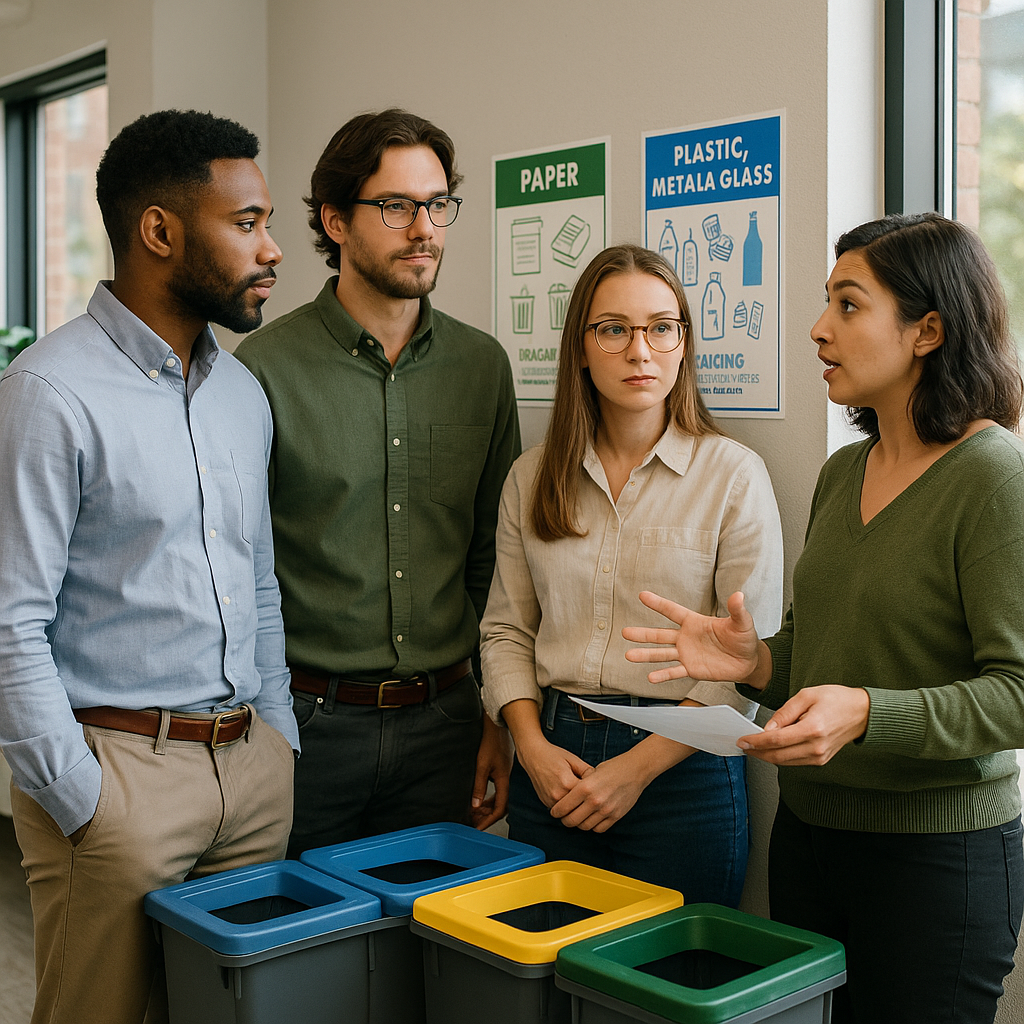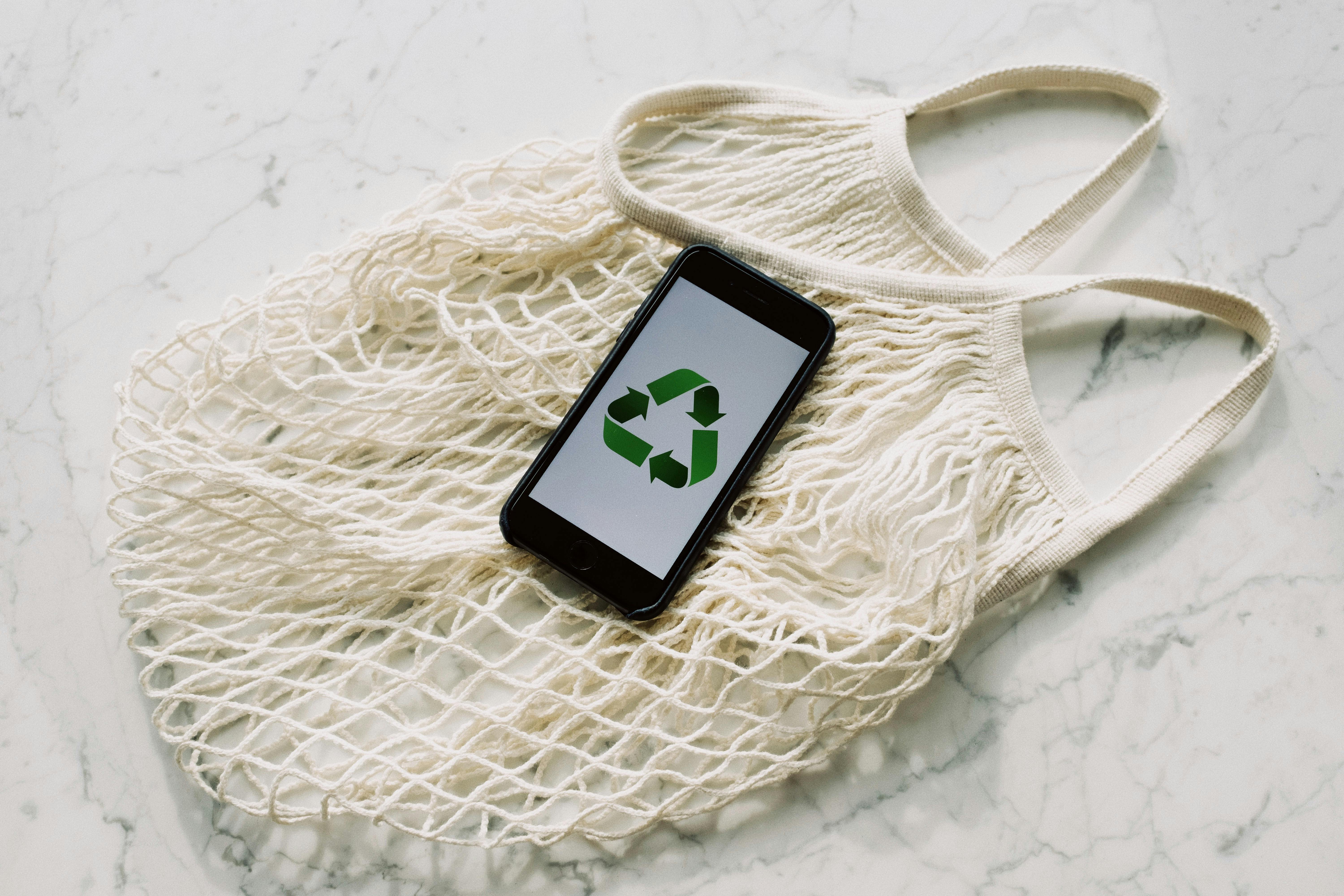5901 Botham Jean Blvd, Dallas, TX 75215
Office Recycling Plans: How to Create and Maintain a Sustainable Workplace
July 11, 2025A recycling plan for office buildings provides a structured framework designed to minimize waste and enhance resource recovery in commercial environments. It acts as a roadmap for businesses aiming to improve environmental performance while potentially reducing operational costs. These plans change how office buildings manage the various waste streams they produce daily.
A recycling plan starts with a comprehensive waste audit to identify the materials your office discards. This assessment uncovers opportunities for recycling, reuse, and waste reduction. Based on the audit results, businesses can implement collection systems with strategically placed bins and clear signage to facilitate recycling for employees.
Employee education is another vital component of an effective recycling plan. Staff need to understand not only what to recycle, but also why their participation is important. Regular monitoring and continuous improvement complete the cycle, ensuring the program evolves to meet changing needs. A properly implemented recycling plan not only diverts waste but also generates cost savings, enhances corporate social responsibility, and promotes a workplace culture that values sustainability.
How do you conduct a waste audit for an office building?

Conducting a waste audit is a crucial first step in developing a recycling plan. This systematic examination of your office waste stream provides valuable data to implement effective recycling programs. A well-executed waste audit reveals not just what you are discarding, but also opportunities to reduce costs and environmental impact.
The waste audit process involves collecting, sorting, and analyzing the waste generated in your office over a specific timeframe. This analysis helps identify significant waste sources and pinpoints where recycling efforts will have the greatest impact.
Step-by-Step Waste Audit Process
A successful office waste audit follows a structured approach. Here’s how to conduct one effectively:
1. Assemble your team and set a date
Form a diverse audit team with representatives from different departments. Choose a typical business week that reflects normal operations. Inform cleaning staff to preserve the waste during the audit period rather than disposing of it.
Consider appointing a sustainability committee that can oversee both the audit and subsequent recycling initiatives. Having cross-departmental representation ensures comprehensive insights and builds organization-wide commitment.
2. Define waste categories and gather supplies
Identify common waste types in your office to create sorting categories. Prepare the necessary supplies, including gloves, masks, scales, sorting tables, and clearly labeled containers for each waste category.
Essential safety equipment includes heavy-duty gloves, aprons or coveralls, and safety glasses. For measurement, you’ll need a digital scale, sorting surfaces, and data collection forms.
3. Collect waste samples
Gather all trash and recycling from designated areas throughout your office building. Label each bag according to its department or location of origin. This allows for more targeted interventions later.
Weigh all collected trash and recyclables separately to establish baseline measurements. This data serves as your starting point for measuring future improvements.
4. Sort and categorize
Wearing protective gear, sort the collected waste into predetermined categories. Place each type of material into its designated container and note any recyclables found in general waste bins.
- Paper (office paper, newspapers, magazines)
- Cardboard (shipping boxes, packaging)
- Plastics (bottles, containers, packaging)
- Glass (bottles, jars)
- Metals (cans, foil, paperclips)
- Food waste (leftovers, coffee grounds)
- Electronics (outdated equipment, batteries)
- Other (non-recyclable items)
After sorting, weigh each category to determine its percentage of your total waste stream. Take photographs of sorted materials for reference and future training purposes.
5. Analyze results and identify opportunities
Calculate your current waste diversion rate by dividing the weight of recyclables by the total waste weight and multiplying by 100. This percentage shows how much waste is being diverted from landfills.
Look for patterns in the data. Which departments generate the most waste? What recyclable materials are commonly thrown in the trash? Are certain items contaminating your recycling stream?
This analysis reveals clear opportunities for improvement, such as placing more recycling bins in high-waste areas or providing better education about what can be recycled.
Turning Audit Findings Into Action
The value of a waste audit lies in how you use the results. After completing your analysis:
Establish clear goals based on your findings. For example, aim to increase paper recycling by 30% or reduce contamination in recycling bins by 20% within six months.
Develop targeted strategies to address problem areas identified in the audit. This might include introducing new recycling streams, repositioning collection bins, or implementing staff training programs.
Create a timeline for implementation and regular follow-up assessments. Plan to conduct mini-audits quarterly to track progress and adjust strategies as needed.
Share audit results with all staff members to build awareness and motivation. Visual representations of waste data often have more impact than statistics alone.
A waste audit is not a one-time event but the beginning of an ongoing process of waste management improvement. Regular monitoring ensures your recycling programs remain effective and adapt to changing office needs.
What are the key components of an effective office recycling program?

An effective office recycling program requires strategic planning and thoughtful implementation. Successful programs do more than simply place bins around the office; they involve careful assessment of waste streams, employee education, and ongoing improvement processes to maximize participation and impact.
Conducting a waste audit forms the foundation of any effective recycling initiative. Before launching a program, businesses should assess the types and volumes of waste their office generates. This analysis identifies the most significant sources of waste and creates a baseline for measuring future progress. A thorough waste audit reveals which materials are most commonly discarded and helps tailor recycling efforts to specific needs.
Strategic placement of recycling bins plays a crucial role in program success. Bins should be conveniently located near areas where recyclable materials are frequently generated. For paper recycling, bins should be near printers, copiers, and workstations. Bins for bottles and cans are best placed in break rooms and cafeterias. When recycling is easily accessible, participation rates increase significantly.
Clear labeling and signage are essential to eliminate confusion about what can and cannot be recycled. Each bin should have visible, straightforward instructions with visual cues to help employees quickly identify the correct disposal location. Some offices successfully use color-coded systems to distinguish between different types of recyclables.
Employee education and engagement are the backbone of successful recycling programs. Regular training sessions, informative newsletters, and awareness campaigns help staff understand the importance of recycling and the proper procedures to follow. The most effective programs incorporate recycling education into new employee orientation and provide periodic refreshers to maintain awareness.
Leadership commitment demonstrates the program’s importance throughout the organization. When management actively participates and endorses recycling initiatives, employees are more likely to follow suit. This commitment is shown through policy development, allocation of resources, and visible participation in recycling activities.
Creating a dedicated green team or recycling committee helps sustain momentum. This group is responsible for monitoring the program, addressing challenges, and implementing improvements. They become recycling champions who encourage participation and serve as resources for questions about proper recycling practices.
Regular monitoring and assessment allow for continuous improvement. Tracking the volume of materials recycled, conducting periodic waste audits, and gathering feedback help identify areas for enhancement. This data-driven approach ensures the program evolves to meet changing needs and address any issues that arise.
Recognition and incentive programs acknowledge employee efforts and maintain enthusiasm. Celebrating milestones, sharing success stories, and rewarding departments with high participation rates can boost morale and encourage continued engagement. Some offices hold friendly competitions between departments to increase participation.
Establishing partnerships with reliable recycling service providers ensures collected materials are properly processed. These partnerships can also provide valuable resources, such as educational materials, signage, and data on recycling performance. Working closely with service providers helps optimize collection schedules and address any operational challenges.
Feedback mechanisms allow employees to share suggestions, report issues, and contribute to program improvements. Regular surveys, suggestion boxes, or digital platforms for sharing ideas create a sense of ownership and involvement. When employees see their input being implemented, they become more invested in the program’s success.
How can offices overcome common recycling challenges?

Office recycling programs often face significant obstacles despite good intentions. A lack of employee awareness and participation is one of the most common challenges. Many staff members remain uncertain about proper recycling practices or do not prioritize these activities during busy workdays. This knowledge gap leads directly to other problems like improper sorting and contamination.
Contamination poses a particularly serious threat to recycling efforts. When non-recyclable items mix with recyclables, entire batches can become unusable. Food residue on containers, plastic bags placed in paper recycling, or coffee cups with plastic linings frequently compromise otherwise recyclable materials. Such contamination not only wastes resources but also undermines employee confidence in the program’s effectiveness.
Accessibility presents another hurdle. Recycling bins positioned inconveniently or lacking clear signage create barriers to participation. When employees must walk significant distances to recycle properly, many opt for the nearest trash bin instead. Without strategically placing recycling stations throughout the workspace, even motivated staff may abandon good intentions during hectic days.
Education and Engagement Strategies
Comprehensive education is the foundation of any successful recycling program. Clear communication about what items can be recycled helps eliminate confusion. Training sessions, informative posters, and regular email updates keep recycling top-of-mind for employees. Specific instructions about cleaning containers or removing contaminants provide practical guidance rather than vague directives.
Engaging employees requires more than just information—it demands making recycling meaningful and relevant. Creating a recycling team with representatives from different departments spreads ownership throughout the organization. These team members can address concerns specific to their areas and encourage participation among their peers. Regular updates on recycling success rates help employees see the tangible impact of their efforts.
Interactive approaches often yield better results than passive information sharing. Short quizzes about recycling practices, lunch-and-learn sessions with local recycling experts, or even facility tours of recycling centers can transform abstract concepts into concrete understanding. These activities foster personal investment in recycling outcomes beyond mere compliance with office policies.
Physical Solutions and Infrastructure
Strategic placement of recycling bins significantly improves participation rates. Position bins in high-traffic areas such as near printers, in break rooms, and along main corridors. No employee should need to walk more than 10-15 steps from their workstation to reach a recycling bin. This convenience removes barriers and encourages consistent recycling habits.
Clear, consistent signage provides vital visual cues. Color-coded bins with distinct labels help employees quickly identify the appropriate receptacle. Consider using images alongside text to show examples of acceptable items. Signage should be placed at eye level and use simple language rather than technical recycling terminology that might confuse users.
Regular audits help identify problem areas and measure progress. Brief inspections of bin contents can reveal common contamination issues or underutilized recycling stations. These findings guide targeted improvements rather than broad, ineffective changes. Tracking waste volumes provides quantifiable metrics to demonstrate the program’s impact to both leadership and employees.
Building a Sustainability Culture
Incentives and recognition programs boost participation by acknowledging employee efforts. Competitions between departments can create positive peer pressure while making recycling more engaging. Recognition for individuals who consistently recycle correctly reinforces these behaviors. Even simple acknowledgments like email shout-outs or small rewards like reusable water bottles signal that the organization values these contributions.
Leadership involvement demonstrates organizational commitment. When executives visibly participate in recycling initiatives, they establish these practices as company priorities rather than optional activities. Leaders should regularly communicate recycling goals and achievements in company meetings. Their consistent messaging helps integrate sustainability into the organizational identity.
Adapting programs to specific office environments increases relevance and effectiveness. A legal firm generating primarily paper waste needs different solutions than a food service operation producing organic waste. Tailoring initiatives to address the specific waste streams and workplace habits of each office creates more practical and successful programs. This customization shows employees that recycling efforts are thoughtfully designed rather than generic requirements.
How to Measure and Improve the Success of an Office Recycling Program?

Measuring the success of an office recycling program requires systematic tracking of key performance indicators (KPIs). Without proper measurement, determining the real impact of your sustainability efforts becomes impossible. Four essential metrics can transform how you evaluate your recycling program’s effectiveness and guide continuous improvement.
Essential KPIs for Tracking Recycling Success
The diversion rate is a crucial metric for any recycling program. This percentage indicates how much waste is redirected from landfills through recycling or composting efforts. Calculate it using a simple formula: Weight of Recycling ÷ (Weight of Recycling + Weight of Garbage) × 100. High-performing facilities often achieve diversion rates exceeding 50%, providing a benchmark for your office to target.
The contamination rate measures the percentage of non-recyclable items mistakenly placed in recycling bins. This metric is increasingly important because contamination can render entire batches of recyclables unusable. Through waste audits, you can identify commonly misplaced items and address these issues through targeted education and clearer signage. The formula is straightforward: Weight of Non-Recyclable Items ÷ Weight of Total Recycled Materials.
The capture rate reveals the percentage of potentially recoverable materials that actually enter the recycling stream. This KPI indicates your program’s efficiency in collecting recyclables that might otherwise end up in landfills. By conducting regular waste audits, you can calculate this rate and identify opportunities to enhance recycling accessibility and education throughout your office.
Implementing Effective Tracking Systems
Regular waste audits form the foundation of any successful measurement strategy. These systematic examinations of your office waste streams provide critical data on material disposal and ensure they go to the right place. Schedule audits quarterly to establish baseline metrics and track improvements over time.
Partner with your waste management provider to obtain detailed reports on the volume and weight of materials collected. Most recycling service providers can supply monthly or quarterly reports detailing the weight of different waste streams. These reports offer valuable insights into seasonal variations and long-term trends in your recycling program.
Digital tracking tools streamline data collection and analysis. Several specialized software solutions and apps allow you to input waste data, generate reports, and visualize trends over time. These tools make it easier to share results with stakeholders and identify patterns that might otherwise go unnoticed.
Gathering Employee Feedback
Anonymous surveys capture honest opinions about your recycling program’s accessibility and effectiveness. Ask specific questions about bin placement, signage clarity, and potential barriers to participation. Distribute these surveys semi-annually to track changing perceptions and gather new improvement ideas.
Focus groups provide deeper insights than surveys alone. Gather representatives from different departments to discuss recycling challenges and brainstorm solutions. These sessions often reveal unexpected obstacles and generate creative approaches to improving participation rates.
Suggestion boxes or digital feedback channels give employees ongoing opportunities to share observations. Place physical suggestion boxes near recycling stations or create a dedicated email address for sustainability feedback. This continuous input helps identify issues before they become significant problems.
Turning Metrics into Improvements
Set realistic, incremental goals based on your baseline measurements. Instead of aiming for perfection immediately, establish progressive targets for each KPI. For example, if your current diversion rate is 30%, set a goal to reach 35% within six months through specific interventions.
Share results transparently with all employees to maintain engagement. Regular updates on recycling metrics demonstrate that their efforts matter and help sustain momentum. Consider creating a visual dashboard in common areas showing progress toward goals.
Implement targeted improvements based on data and feedback. If contamination rates are high for specific items, enhance signage with clear images of those problematic materials. If certain areas show lower participation, consider bin relocation or additional education for those departments.
Celebrate achievements when milestones are reached. Recognition reinforces positive behaviors and builds a culture of sustainability. Consider department competitions or company-wide rewards when significant improvements occur in your recycling metrics.
Continuous measurement and improvement create a virtuous cycle for recycling programs. By consistently tracking KPIs, gathering employee input, and implementing data-driven changes, your office can significantly reduce its environmental footprint while potentially realizing cost savings from reduced waste disposal. This systematic approach ensures that sustainability initiatives remain effective and aligned with your organization’s environmental goals.
Conclusion: Implementing a Successful Recycling Plan for Office Buildings
Creating a successful recycling program for office buildings requires a methodical approach that begins with understanding your waste stream. Conducting waste audits reveals the materials your office generates and identifies opportunities for reduction and diversion. With this knowledge, you can develop a strategic plan that includes proper infrastructure, clear signage, and convenient recycling stations throughout your workplace.
Employee engagement is the cornerstone of any effective recycling initiative. When staff understand the reasons behind recycling efforts and receive proper education on sorting practices, participation rates increase dramatically. Regular monitoring, measurement, and program adjustments ensure continuous improvement and long-term success. A well-executed recycling plan delivers multiple benefits: reduced waste hauling costs, enhanced corporate reputation, improved employee satisfaction, and meaningful environmental impact. For professional guidance on implementing or improving your office recycling program, contact Okon Recycling at 214-717-4083.
